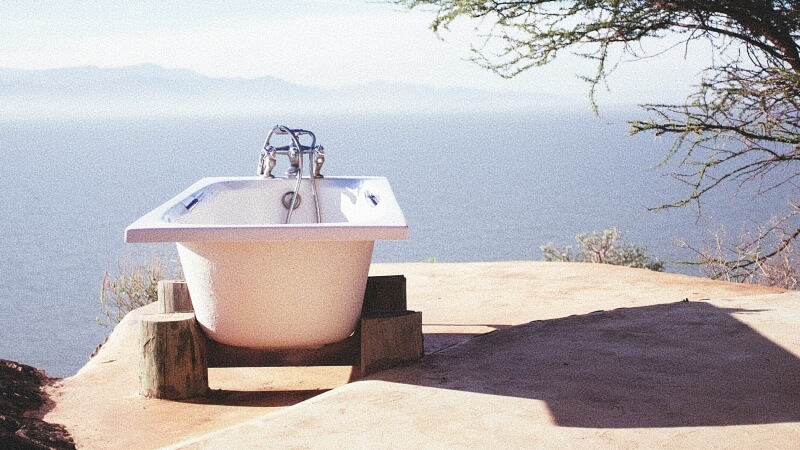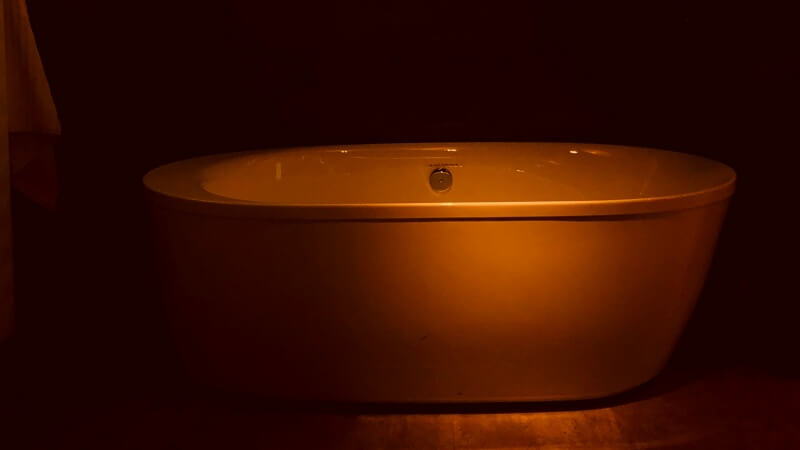
DIY Crafting A Cover For Your Portable Bathtub: A Creative Guide
Do you ever wish your portable bathtub had a bit more pizzazz or perhaps some added privacy? Well, you’re in luck! Crafting a DIY cover

Limescale can make your bathroom look dirty and unclean. So, what’s the best way to remove limescale from your bathroom?
People often want to get rid of limescale because it makes things look bad. If you don’t clean it for a while, it can leave tough stains.
This guide is here to explain what limescale is, if it’s harmful, and how to remove it.
Keep reading to learn how to clean limescale from your bathroom and how to stop it from coming back…
Limescale is essentially a hard, chalky deposit mainly made of calcium carbonate. It’s left behind by hard water – water with lots of minerals – when it dries up.
You’ll usually see limescale in places like kettles, boilers, and pipes. It’s common in areas with warm water. In bathrooms, it often appears on taps, shower heads, and plugholes.
Limescale can also form when soap suds aren’t washed away. So, things like sinks, mirrors, and tiles can get it, and even your toilet can be affected.
Limescale can range from being a small annoyance to causing serious issues in your home, like clogged pipes or even cracks.
On a less serious note, limescale can gather on surfaces that touch hard water, like your taps and shower heads. If it’s not cleaned, it can slow down the water flow, making them less effective.
A decrease in water flow can mean your appliances don’t work right. For example, your toilet might not flush properly, which could impact the cleanliness of your home. To sum up, limescale itself isn’t harmful, but the problems it leads to can be.
There are many methods to remove limescale, including store-bought products and homemade mixtures. If you prefer not to use harsh chemicals or want to be more eco-friendly, there are still easy ways to clean limescale.
Since you often clean yourself in the bathroom, consider using natural cleaners like vinegar or lemon to tackle limescale.
When cleaning your bathroom, always wear gloves. You might also need:
Remember, lemon juice is citric acid, so always wear gloves when using it.
No matter where the limescale is in your bathroom, whether visible or hidden, it’s easier to clean than you might think…
Just because you can’t see or reach the limescale in your pipes doesn’t mean you can’t clean it.
Preparing to clean your pipes is like getting ready to unclog a drain. You’ll need to set aside some time and keep the bathroom unused for a while.
To clear limescale from pipes, you can either use commercial cleaners from stores or a homemade vinegar and baking soda mix. This natural solution is great if you have pets, children, or allergies.
For this method, mix eight liters of white vinegar with one cup of baking soda for each drain. This mix works for both your sink and bathtub. Before using the solution, make sure the pipes are as empty as possible.
Start by adding baking soda to each drain. It’s easier if you can take out the plug. Then, pour the vinegar slowly and let it sit for 3-4 hours. Afterward, to ensure all grease, soap, or calcium is gone, pour boiling water down the drain quickly.
To clean limescale off taps, natural cleaners like vinegar or lemon are often best, aside from chemical cleaners.
There are two main parts to focus on when removing limescale from taps: the levers and body, and the water outlet. These parts are most prone to limescale. They need to be thoroughly soaked in a cleaning solution.
For the spout, use a cap filled with lemon juice or vinegar. Cover the spout with it, making sure it’s fully immersed, and secure the cap with tape or an elastic band. Leave it overnight.
Lemon juice is especially effective for tougher limescale.
For the upper parts of the tap, soak cotton wool or cloth in white vinegar or lemon juice and wrap it around. Use an elastic band for extra hold if needed. Leave it for a few hours or overnight, depending on the limescale buildup.
You might need to gently scrub the taps afterward to remove any leftover residue.
Be cautious when using vinegar or lemon on plated taps, like chrome or gold, as it can damage the finish.
A useful tip is to cut a lemon in half and press it onto the tap spout. It might even stay in place by itself. After cleaning, give the taps a rub with a clean cloth for added shine.
You can use common chemical cleaners to remove limescale from your toilet, but vinegar is also effective.
When using store-bought cleaners, keep in mind they contain bleach. Make sure your bathroom is well-ventilated and avoid skin contact. These cleaners are good for reaching under the rim and usually come in bottles designed for this purpose. They generally take about 30 minutes to take effect.
To clean limescale from your toilet bowl with vinegar, the method depends on how much and how thick the limescale is. For light limescale, mix vinegar with water in a spray bottle. Spray it on the stain and scrub it off.
For tougher limescale, pour a whole bottle of white vinegar in and around the bowl, covering it completely. Let it sit for a few hours or overnight. The next day, scrub off any remaining limescale with a toilet brush. For the rim, spray the vinegar solution and then scrub it.
If you find really tough limescale in the bowl, gently sand it off with sandpaper. Be careful not to scrub too hard to avoid damaging the bowl. Flush away the residue, then clean as usual.
If water from your shower head sprays unevenly, it’s probably clogged with limescale. You can clean it using vinegar or lemon juice.
First, take off the shower head and put it in a bowl or bucket. Pour in warm water until the shower head is submerged.
Mix water with vinegar or lemon juice in the bowl. Freshly squeezed lemon juice is better than store-bought. Soak the shower head for 20-30 minutes. Lemon usually works faster than vinegar. For vinegar, you might need to soak it a few times for 30 minutes each.
After soaking, rinse the shower head and scrub off any remaining limescale. It should now be clean. Lemon juice is particularly good for chrome shower heads.
For cleaning other bathroom surfaces like tiles and bathtubs, mix vinegar or lemon juice with warm water in a spray bottle. Use a 1:3 ratio of vinegar to water.
Spray it on, wait up to 30 minutes, then scrub and wipe the area with a soft cloth.
Using the cleaning methods we’ve talked about regularly can help stop limescale from appearing, so if you clean often, it might not come back.
Since limescale is caused by hard water, putting a water softener in your water supply is one way to deal with it.
An easier method to prevent limescale is to dry off any wet areas with a cloth or a shower squeegee, just like you would to avoid mold. On glass things, like shower screens, be sure to wipe them completely dry after you shower.
Efficiently dealing with limescale doesn’t have to be challenging. Here are some straightforward tips to keep it under control:
Now that you know how to handle limescale in your bathroom, think about making things even better with our cool product: Portable Bathtub.
With the Portable Bathtub in the bathroom, you can have a chill bath time without stressing about limescale. It’s a clever and useful thing to add to your bathroom, giving you both ease and a nice time.
Wave goodbye to limescale problems and welcome easy, fun bath times with the Portable Bathtub.


Do you ever wish your portable bathtub had a bit more pizzazz or perhaps some added privacy? Well, you’re in luck! Crafting a DIY cover

Have you ever longed for extra comfort in your portable bathtub? Imagine enhancing your bathing experience with custom-made chairs and loungers tailored just for you.

When it comes to adding a personal touch to your home, your portable bathtub should not be an exception. This post will guide you through

Imagine stepping into your portable bathtub and finding the water temperature just perfect – every single time. This isn’t just a dream; it’s entirely achievable

Do you ever wish your portable bathtub had a bit more pizzazz or perhaps some added privacy? Well, you’re in luck! Crafting a DIY cover

Have you ever longed for extra comfort in your portable bathtub? Imagine enhancing your bathing experience with custom-made chairs and loungers tailored just for you.

When it comes to adding a personal touch to your home, your portable bathtub should not be an exception. This post will guide you through

Imagine stepping into your portable bathtub and finding the water temperature just perfect – every single time. This isn’t just a dream; it’s entirely achievable
Copyright © 2025 batheportablebathtub. All Rights Reserved.